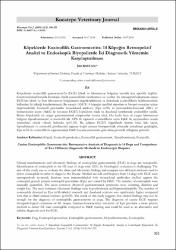| dc.contributor.author | Bastan, İdil | |
| dc.date.accessioned | 2019-02-04T10:32:29Z | |
| dc.date.available | 2019-02-04T10:32:29Z | |
| dc.date.issued | 2018 | |
| dc.identifier.uri | http://dergipark.gov.tr/kvj/issue/37070/436105 | |
| dc.identifier.uri | http://hdl.handle.net/11630/5322 | |
| dc.description.abstract | Köpeklerde eozinofilik gastroenterit’in (EGE) klinik ve laboratuvar bulguları hastalık için spesifik değildir. Gastrointestinal kanalda histolojik olarak eozinofillerin belirlenmesi ise zordur. Bu retrospektif çalışmanın amacı EGE’nin klinik ve bazı laboratuvar bulgularının değerlendirilmesi ve dokularda eozinofillerin belirlenmesinde kullanılan iki tekniği karşılaştırmaktı. Bu amaçla EGE’li 14 köpeğin medikal raporları ve biyopsi sonuçları tekrar değerlendirildi. Eozinofil peroksidaz monoklonal antikoru (Epx mAb) ile immunohistokimyasal (IHC) ve hematoksilen eozin (H&E) ile boyanan EGE’li köpeklerin mide ve duodenal kesitlerinde eozinofiller sayıldı. Bütün köpeklerde en yaygın gastrointestinal semptomlar kusma ishal, kilo kaybı iken en yaygın laboratuvar bulgusu hipoalbuminemi ve eozinofili idi. EPX ile saptanan eozinofillerin sayısı H&E ile saptananlara oranla istatistiksel olarak yüksek bulundu (p≤0.05). Bu çalışma EGE’li köpeklerde kusma ishal, kilo kaybı, hipoalbünemi ve eozinofili görülmesine rağmen doğru tanının histopatolojik yöntemle konulması gerektiğini, Epx mAb ile eozinofillerin saptanmasıda H&E boyama yöntemine göre daha güvenilir olduğunu gösterdi. | en_US |
| dc.description.abstract | Clinical manifestations and laboratory findings of eosinophilic gastroenteritis (EGE) in dogs are nonspecific. Identification of eosinophils in the GI tract of dogs with EGE, by histological evaluation is challenging. The aim of this study was to evaluate the clinic and laboratory findings and compare two different methods used to detect eosinophils in order to diagnose the disease. Medical records and biopsies from 14 dogs with EGE were retrospectively reviewed. Sections were immunolabeled with monoclonal antibodies (mAbs) against the eosinophil granule protein eosinophil peroxidase (Epx) and stained by H&E. The number of eosinophils were manually quantified. The most common observed gastrointestinal symptoms were vomiting, diarrhea and weight lost. The most common laboratory findings were hypoalbunemia and hypereosinophilia. The number of eosinophils detected in Epx mAb-labeled stomach and duodenal sections was significantly higher compared with that in H&E-stained sections (p≤0.05). The result of this study suggests that clinical findings may not be enough for the diagnosis of eosinophilic gastroenteritis in dogs. The diagnosis of canine EGE requires histopathological evaluation of GI biopsy. Immunohistochemical detection of Epx provides a more precise method to detect GI tract eosinophils compared to H&E staining and could be used as an alternative and reliable diagnostic tool for EGE. | |
| dc.language.iso | tur | en_US |
| dc.identifier.doi | 10.30607/kvj.436105 | en_US |
| dc.rights | info:eu-repo/semantics/openAccess | en_US |
| dc.subject | Köpek | en_US |
| dc.subject | Eozinofil Peroksidaz | |
| dc.subject | Eozinofilik Gastroenterit | |
| dc.subject | Hipoalbuminemi | |
| dc.subject | Eozinofili | |
| dc.subject | Dog | |
| dc.subject | Eosinophil Peroxidase | |
| dc.subject | Eosinophlic Gastroenteritis | |
| dc.subject | Hypoalbuminemia | |
| dc.subject | Eosinophlia | |
| dc.title | Köpeklerde eozinofilik gastroenteritis: 14 köpeğin retrospektif analizi ve endoskopik biyopsilerde iki diagnostik yöntemin karşılaştırılması | en_US |
| dc.title.alternative | Canine eosinophilic gastroenteritis: retrospective analysis of diagnosis in 14 dogs and comparison of two different diagnostic methods in endoscopic biopsies | en_US |
| dc.type | article | en_US |
| dc.relation.journal | Kocatepe Veteriner Dergisi | en_US |
| dc.department | Ankara Üniversitesi, Veteriner Fakültesi | en_US |
| dc.identifier.volume | 11 | en_US |
| dc.identifier.startpage | 316 | en_US |
| dc.identifier.endpage | 321 | en_US |
| dc.identifier.issue | 3 | en_US |
| dc.relation.publicationcategory | Makale - Ulusal Hakemli Dergi - Kurum Yayını | en_US |



















